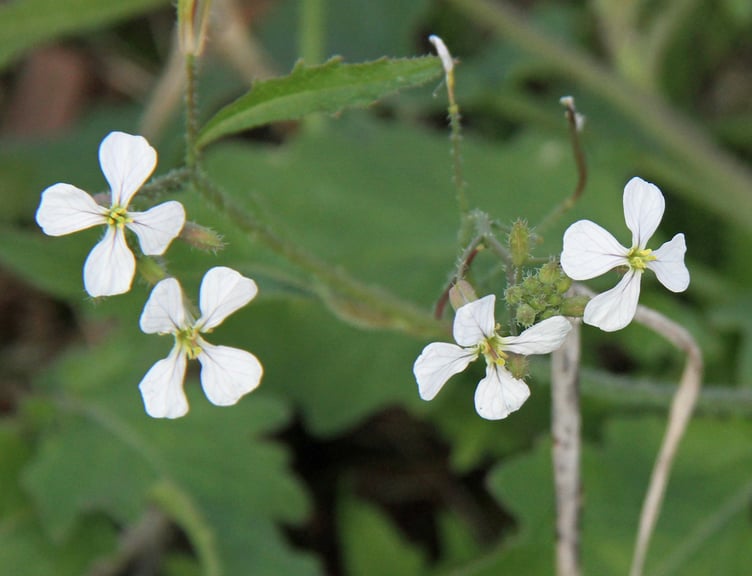I walked through the corn stubble on the path field near the village to see how many dames violet plants had produced flowers. Only two that I could find, but what I cannot understand is; how did they come to be growing in the middle of a field?
These white, four petalled flowers are not really true violets but they do produce a violet smelling aroma during humid evenings. They were introduced from central Europe during the 16th century as a garden flower but, as usual with these introductions, they quickly escape into fields and hedgerows. But I wonder why this particular field is the only place I have seen them growing.
Whilst walking around this corn field I could not miss seeing nearly a dozen Large Red slugs feeding on the new shoots of corn that were growing from grain spilled from the combined harvester. These slugs were at least 12mm long (over four inches in old money) and I thought they were in danger of being gobbled up by members of the Crow family.
On a warm, three mile circuit of the village lanes I only saw one butterfly, a speckled wood, that kept me company for a couple of hundred metres with its to-and-fro flight. There are usually two generations of this butterfly, the first flies in early spring and the second from July to October.
I also spotted a couple of empty wood pigeon’s eggs lying beside the hedge. Pigeons lay three or four clutches of two white eggs every year. Unfortunately their nests consist solely of a collection of dried twigs so when the birds leave the nest to find food their two eggs are literally on the centre of a large brown plate and are targets for magpies and jackdaws who take an egg down to the ground where they break it open and eat the contents.
Over at the Trehunsey crossroads there is a lot of traveller’s–joy, a member of the Clematis family, on the hedgerow. Its name suggests travellers will ‘speed’ on their way, but back in the sixties I was made aware of another reason of how it got its name.
Back then I worked at a garage near Looe Fork Road and a traveller, sometimes known as a tramp, would call in occasionally and mechanics would give him some food from our dinner bags and we would fill up his billy can with tea. One day he called in and appeared to be clean shaven and his hair looked short and tidy.
He told us he had spent the night in Liskeard’s cottage hospital and was on his way to Looe. We asked him why he was hospitalised and he told us that he, and other travellers, would rub their arms and chests with a handful of traveller’s–joy which produced a rash on their skin. Then they would call in at the nearest cottage hospital where they would be bathed and shaved and given a bed for the night – hence his tidy appearance.
My first (and last) attempt at growing cauliflowers and swede turnips did nothing but bring loads of large and small white butterflies into the garden. As soon as leaves appeared on the vegetables our uninvited visitors were laying yellow eggs on them. Then the caterpillars hatched out and the leaves started to disappear. Never again.
Finally, I would like to thank Hilary Marshall for helping me to identify the mystery fungus pictured in this column a fortnight ago. This orange fungus is very rare and is known as the ‘ping pong bat’ which, it appears, is also said to be invasive. I think it came originally from Australia or New Zealand during 2012, so is not included in any of my many mushroom books.




.jpeg?width=209&height=140&crop=209:145,smart&quality=75)
Comments
This article has no comments yet. Be the first to leave a comment.